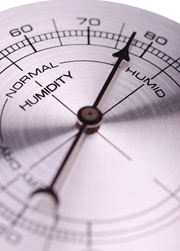
Handing Risks: Managing High Home Humidity Levels
The Environmental Protection Agency (EPA) specifies that there are a number of health problems and respiratory issues that can be associated with poor indoor air quality within our homes. Allergies, ear/nose/throat irritations, asthma, headaches and nausea are just a few symptoms and illnesses that can impede our comfort and health. For respiratory health related issues in particular, these can be directly related to the potential presence of dust mites and fungal particulates (mold) within the home.
When it comes to asthma, allergies and hay fever, the presence of household mold and dust mites are a factor in as much as 80% of cases studied. Additionally, these contaminants may also manifest themselves through a wide variety of skin issues, eye problems and other mild to severe health related symptoms.
Although there are a number of different ways to improve your indoor air quality, It has been found that keeping relative humidity levels low, or within guidelines, is the best way to help reduce the presence of dust mites and mold growth within you home. Managing high home humidity levels is often the key to helping improve air quality.
Mold – Mold is a fungus that thrives in moist conditions and grows by feeding off of organic substances. Aside from causing allergy related symptoms to sensitive individuals, they can be asthma producing and also release harmful mycotoxins and VOC’s into the air we breathe. The presence of a mold contamination within you home can result in a wide variety of symptoms including a runny nose, itchy eyes, coughing, wheezing, skin irritations and rashes, muscle ached, inability to focus/concentrate, fatigue and loss of appetite.
Dust Mites – Dust mites are hardy creatures that are microscopic and thrive in warm, humid environments. They prefer conditions above 70° F and an environment with a relative humidity level of 75-80% Managing the humidity levels within your home can help reduce the presence of dust mites. Relative Humidity Levels below 50% are ideal
Signs of a Problem
Some signs of moisture intrusion within your home might be very obvious, like water staining, visible leaks and condensation on windows. More often, signs of water intrusion may be hidden in the crawl spaces, basements and building envelope of the home. A lack of adequate ventilation or air conditioning systems, particularly within the summer month, may heighten high humidity issues and pose a significant risk to the development of mold growth and dust mites.
What Can Be Done
The most effective solution is proper moisture control and solid efforts in managing high home humidity. Fixing leaks and water intrusion issues quickly and thoroughly is of great importance. A dehumidifier can also offer a great solution. The presence of a dehumidifier in a home can greatly reduce the risk of serious health related issues through proper moisture level maintenance. Opening a window for increased ventilation and using fans in bathrooms when showering can also greatly impact humidity levels within a home. Just make sure all fans are properly venting to the building exterior. If unsure about potential contaminants or the level of humidity within your home, professional air quality testing can help provide the information needed.
(Visited 370 times, 1 visits today)






